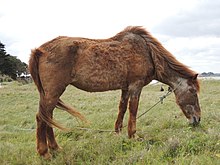
A geriatric horse is an equine that may show signs of physical and mental decline, which generally limits its ability to participate in most equestrian activities. The age at which a horse is considered geriatric can vary by breed and intended use, with older age being reached more quickly in Thoroughbred sport horses than in more robust ponies. Common signs of geriatric horses include dental changes, graying of certain areas on the head, a pronounced arch in the back, and stiffness in movement. Additionally, these animals may become more sensitive to seasonal changes.
From the 18th and 19th centuries onward, the practice of hippophagy, or horse meat consumption, became less restricted by religious prohibitions in Europe, leading to older horses being sold to knackers or slaughtered for their meat. As horses have increasingly gained the status of pets, alternative retirement options have emerged for them at the end of their lives. Such retirements are now more common, and geriatric horses can often be engaged in gentle activities, such as leisure riding. However, geriatric horses can present economic and ethical challenges, as owners may not always anticipate the longevity of their animals or the long-term costs associated with their care. This situation may contribute to concerns about fraud and ethical practices related to the resale of horses for slaughter.